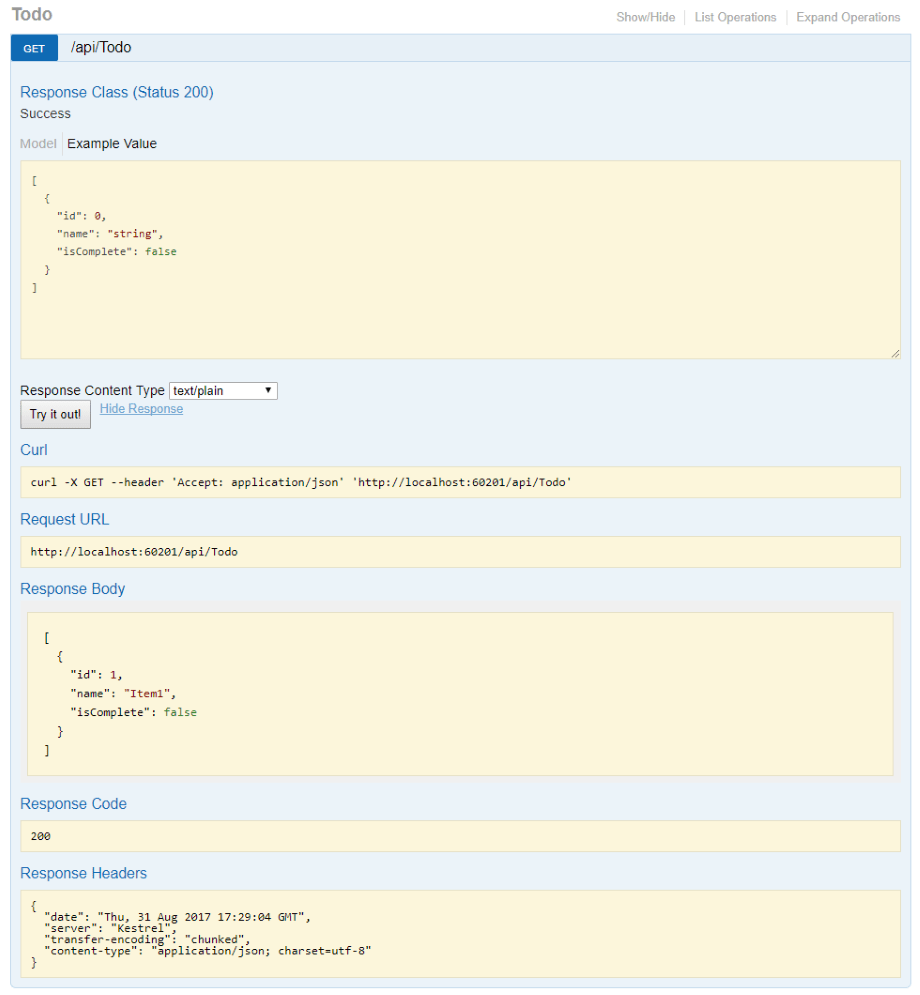
Swagger (OpenAPI) is a language-agnostic specification for describing REST APIs. It allows both computers and humans to understand the capabilities of a REST API without direct access to the source code. Its main goals are to:
The two main OpenAPI implementations for .NET are Swashbuckle and NSwag, see:
The Swagger project was donated to the OpenAPI Initiative in 2015 and has since been referred to as OpenAPI. Both names are used interchangeably. However, "OpenAPI" refers to the specification. "Swagger" refers to the family of open-source and commercial products from SmartBear that work with the OpenAPI Specification. Subsequent open-source products, such as OpenAPIGenerator, also fall under the Swagger family name, despite not being released by SmartBear.
The OpenAPI specification is a document that describes the capabilities of your API. The document is based on the XML and attribute annotations within the controllers and models. It's the core part of the OpenAPI flow and is used to drive tooling such as SwaggerUI. By default, it's named openapi.json . Here's an example of an OpenAPI specification, reduced for brevity:
< "openapi": "3.0.1", "info": < "title": "API V1", "version": "v1" >, "paths": < "/api/Todo": < "get": < "tags": [ "Todo" ], "operationId": "ApiTodoGet", "responses": < "200": < "description": "Success", "content": < "text/plain": < "schema": < "type": "array", "items": < "$ref": "#/components/schemas/ToDoItem" >> >, "application/json": < "schema": < "type": "array", "items": < "$ref": "#/components/schemas/ToDoItem" >> >, "text/json": < "schema": < "type": "array", "items": < "$ref": "#/components/schemas/ToDoItem" >> > > > > >, "post": < … >>, "/api/Todo/": < "get": < … >, "put": < … >, "delete": < … >> >, "components": < "schemas": < "ToDoItem": < "type": "object", "properties": < "id": < "type": "integer", "format": "int32" >, "name": < "type": "string", "nullable": true >, "isCompleted": < "type": "boolean" >>, "additionalProperties": false > > > > Swagger UI offers a web-based UI that provides information about the service, using the generated OpenAPI specification. Both Swashbuckle and NSwag include an embedded version of Swagger UI, so that it can be hosted in your ASP.NET Core app using a middleware registration call. The web UI looks like this:

Each public action method in your controllers can be tested from the UI. Select a method name to expand the section. Add any necessary parameters, and select Try it out!.

The Swagger UI version used for the screenshots is version 2. For a version 3 example, see Petstore example.
Call MapSwagger().RequireAuthorization to secure the Swagger UI endpoints. The following example secures the swagger endpoints:
using System.Security.Claims; var builder = WebApplication.CreateBuilder(args); builder.Services.AddEndpointsApiExplorer(); builder.Services.AddSwaggerGen(); builder.Services.AddAuthorization(); builder.Services.AddAuthentication("Bearer").AddJwtBearer(); var app = builder.Build(); if (app.Environment.IsDevelopment()) < app.UseSwagger(); app.UseSwaggerUI(); >app.UseHttpsRedirection(); var summaries = new[] < "Freezing", "Bracing", "Chilly", "Cool", "Mild", "Warm", "Balmy", "Hot", "Sweltering", "Scorching" >; app.MapSwagger().RequireAuthorization(); app.MapGet("/", () => "Hello, World!"); app.MapGet("/secret", (ClaimsPrincipal user) => $"Hello . My secret") .RequireAuthorization(); app.MapGet("/weatherforecast", () => < var forecast = Enumerable.Range(1, 5).Select(index =>new WeatherForecast ( DateOnly.FromDateTime(DateTime.Now.AddDays(index)), Random.Shared.Next(-20, 55), summaries[Random.Shared.Next(summaries.Length)] )) .ToArray(); return forecast; >) .WithName("GetWeatherForecast") .WithOpenApi(); app.Run(); internal record WeatherForecast(DateOnly Date, int TemperatureC, string? Summary) < public int TemperatureF =>32 + (int)(TemperatureC / 0.5556); > In the preceding code, the /weatherforecast endpoint doesn't need authorization, but the Swagger endpoints do.
The following Curl passes a JWT token to test the Swagger UI endpoint:
curl -i -H "Authorization: Bearer " https://localhost:/swagger/v1/swagger.json For more information on testing with JWT tokens, see Generate tokens with dotnet user-jwts.
Swagger (OpenAPI) is a language-agnostic specification for describing REST APIs. It allows both computers and humans to understand the capabilities of a REST API without direct access to the source code. Its main goals are to:
The two main OpenAPI implementations for .NET are Swashbuckle and NSwag, see:
The Swagger project was donated to the OpenAPI Initiative in 2015 and has since been referred to as OpenAPI. Both names are used interchangeably. However, "OpenAPI" refers to the specification. "Swagger" refers to the family of open-source and commercial products from SmartBear that work with the OpenAPI Specification. Subsequent open-source products, such as OpenAPIGenerator, also fall under the Swagger family name, despite not being released by SmartBear.
The OpenAPI specification is a document that describes the capabilities of your API. The document is based on the XML and attribute annotations within the controllers and models. It's the core part of the OpenAPI flow and is used to drive tooling such as SwaggerUI. By default, it's named openapi.json . Here's an example of an OpenAPI specification, reduced for brevity:
< "openapi": "3.0.1", "info": < "title": "API V1", "version": "v1" >, "paths": < "/api/Todo": < "get": < "tags": [ "Todo" ], "operationId": "ApiTodoGet", "responses": < "200": < "description": "Success", "content": < "text/plain": < "schema": < "type": "array", "items": < "$ref": "#/components/schemas/ToDoItem" >> >, "application/json": < "schema": < "type": "array", "items": < "$ref": "#/components/schemas/ToDoItem" >> >, "text/json": < "schema": < "type": "array", "items": < "$ref": "#/components/schemas/ToDoItem" >> > > > > >, "post": < … >>, "/api/Todo/": < "get": < … >, "put": < … >, "delete": < … >> >, "components": < "schemas": < "ToDoItem": < "type": "object", "properties": < "id": < "type": "integer", "format": "int32" >, "name": < "type": "string", "nullable": true >, "isCompleted": < "type": "boolean" >>, "additionalProperties": false > > > > Swagger UI offers a web-based UI that provides information about the service, using the generated OpenAPI specification. Both Swashbuckle and NSwag include an embedded version of Swagger UI, so that it can be hosted in your ASP.NET Core app using a middleware registration call. The web UI looks like this:

Each public action method in your controllers can be tested from the UI. Select a method name to expand the section. Add any necessary parameters, and select Try it out!.

The Swagger UI version used for the screenshots is version 2. For a version 3 example, see Petstore example.